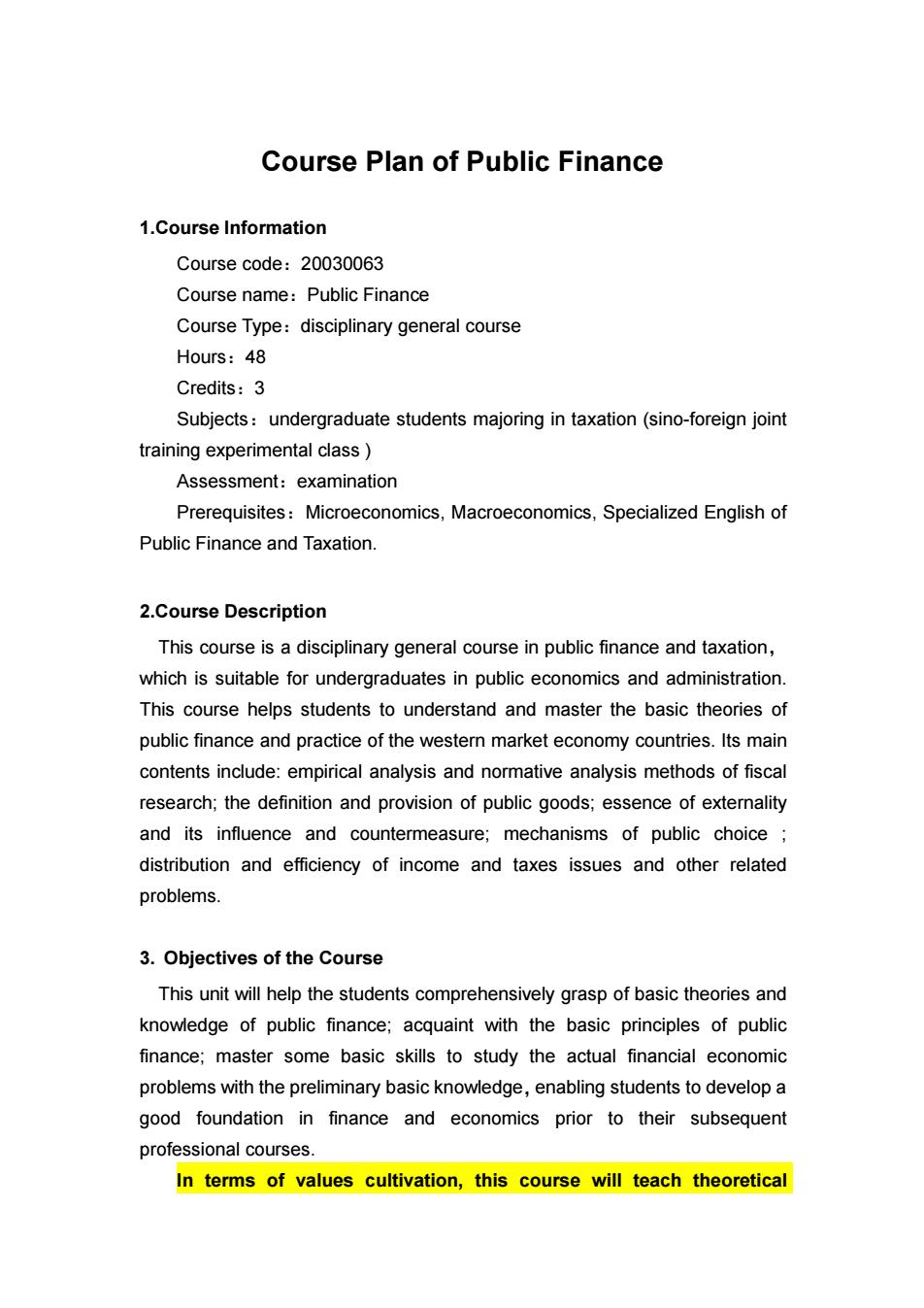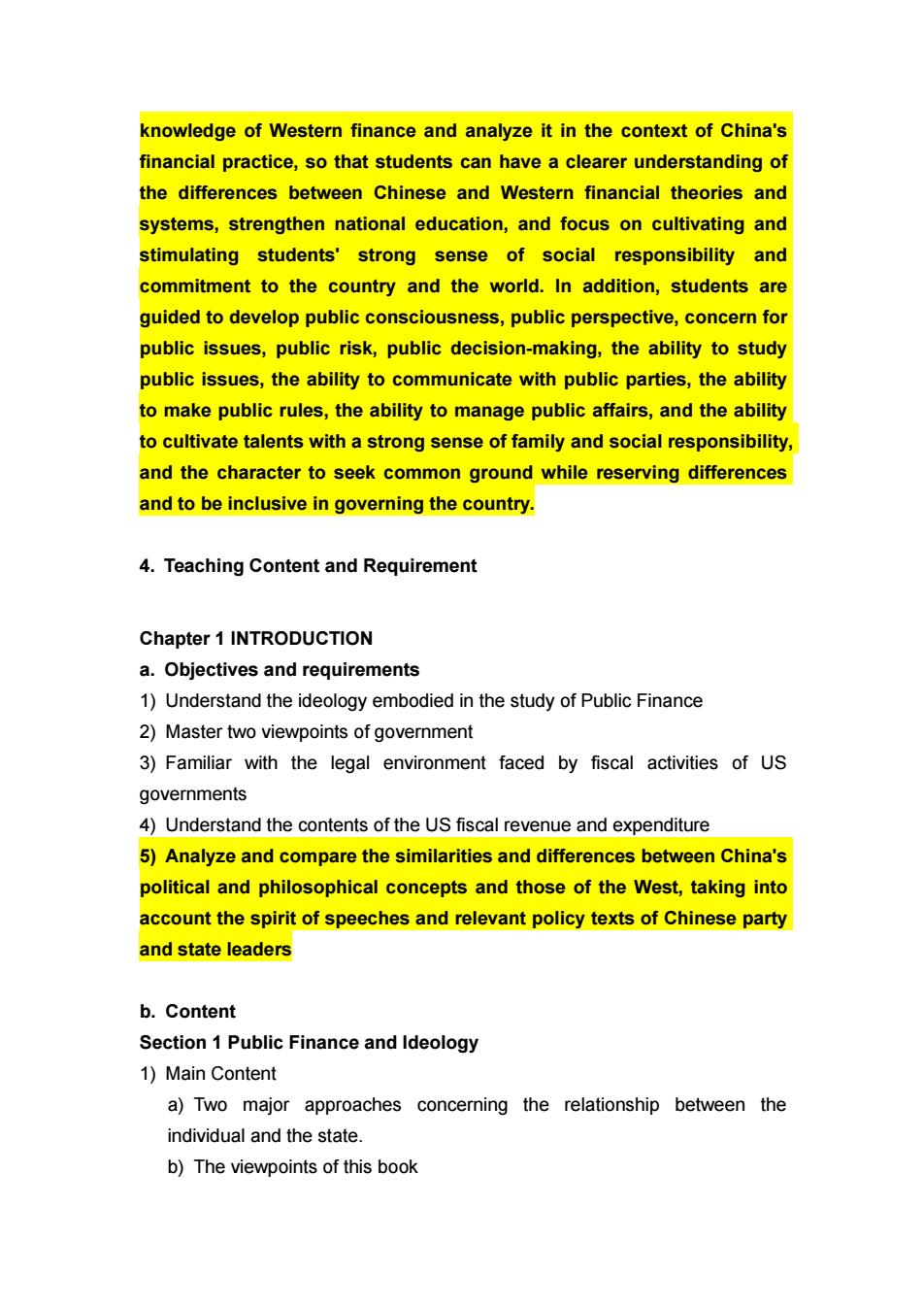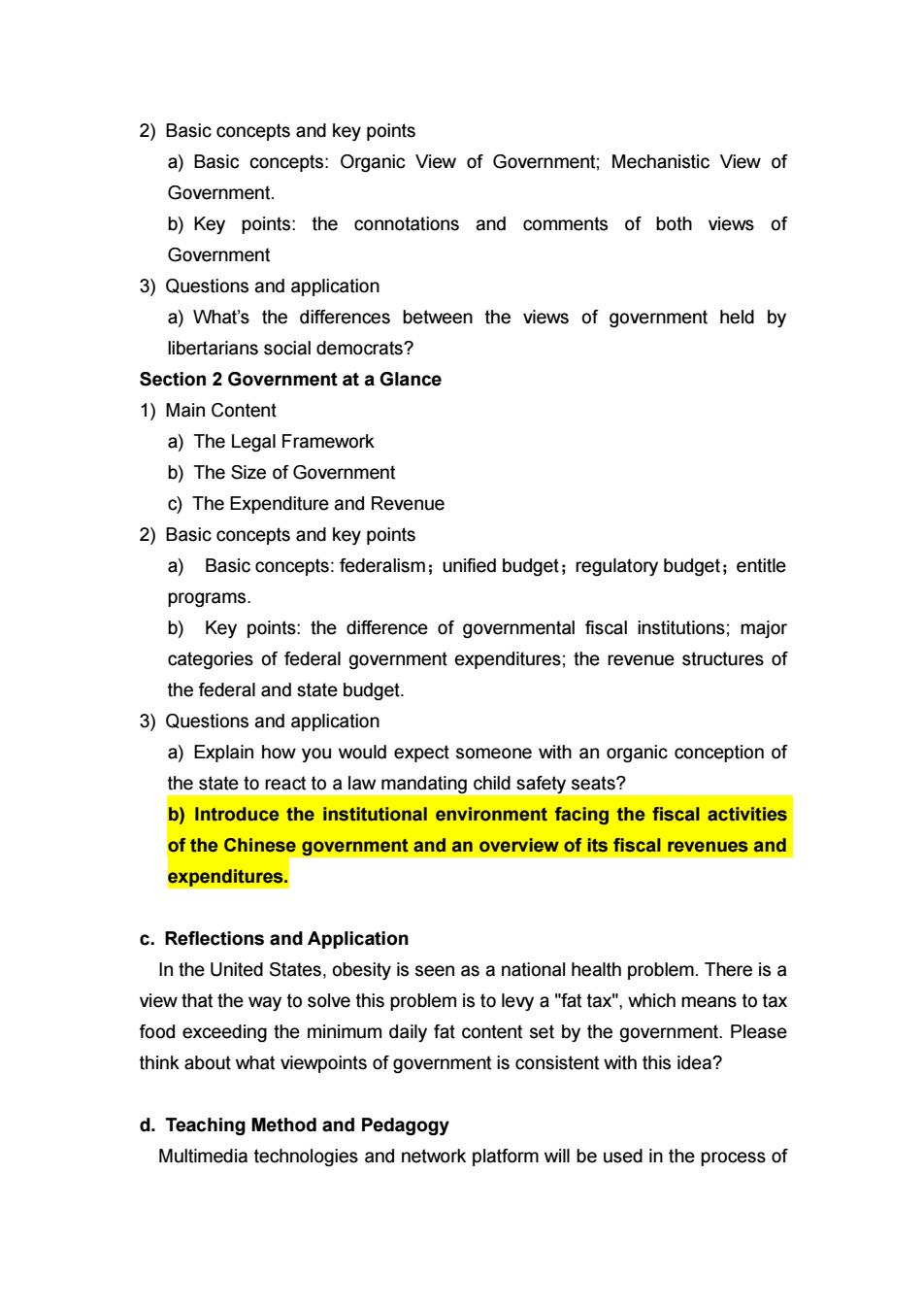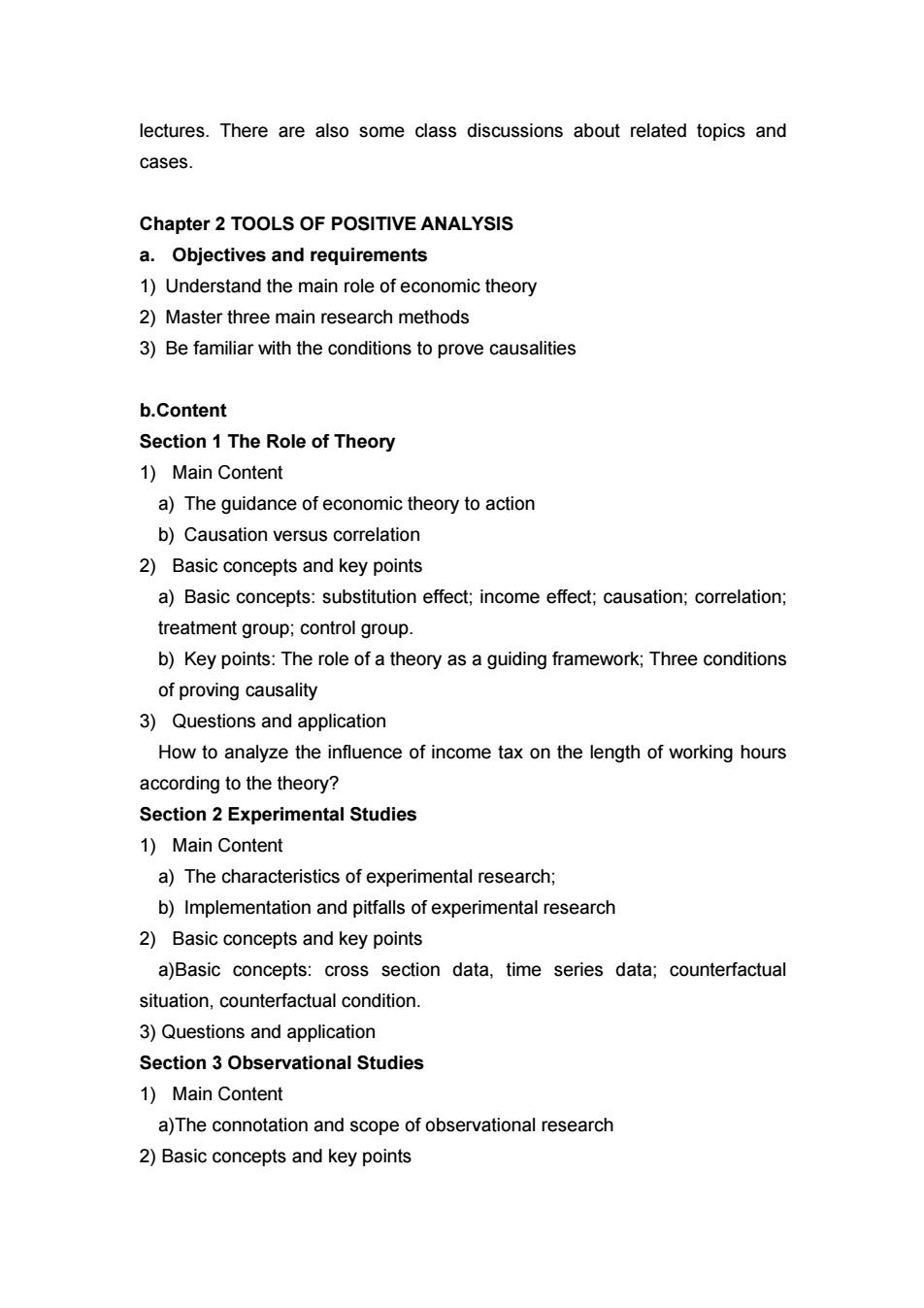
Course Plan of Public Finance 1.Course Information Course code:20030063 Course name:Public Finance Course Type:disciplinary general course Hours:48 Credits:3 Subjects:undergraduate students majoring in taxation(sino-foreign joint training experimental class Assessment:examination Prerequisites:Microeconomics,Macroeconomics,Specialized English of Public Finance and Taxation. 2.Course Description This course is a disciplinary general course in public finance and taxation which is suitable for undergraduates in public economics and administration. This course helps students to understand and master the basic theories of public finance and practice of the western market economy countries.Its main contents include:empirical analysis and normative analysis methods of fiscal research;the definition and provision of public goods;essence of externality and its influence and countermeasure:mechanisms of public choice distribution and efficiency of income and taxes issues and other related problems. 3.Objectives of the Course This unit will help the students comprehensively grasp of basic theories and knowledge of public finance;acquaint with the basic principles of public finance;master some basic skills to study the actual financial economic problems with the preliminary basic knowledge,enabling students to develop a good foundation in finance and economics prior to their subsequent professional courses. In terms of values cultivation,this course will teach theoretical
Course Plan of Public Finance 1.Course Information Course code:20030063 Course name:Public Finance Course Type:disciplinary general course Hours:48 Credits:3 Subjects:undergraduate students majoring in taxation (sino-foreign joint training experimental class ) Assessment:examination Prerequisites:Microeconomics, Macroeconomics, Specialized English of Public Finance and Taxation. 2.Course Description This course is a disciplinary general course in public finance and taxation, which is suitable for undergraduates in public economics and administration. This course helps students to understand and master the basic theories of public finance and practice of the western market economy countries. Its main contents include: empirical analysis and normative analysis methods of fiscal research; the definition and provision of public goods; essence of externality and its influence and countermeasure; mechanisms of public choice ; distribution and efficiency of income and taxes issues and other related problems. 3. Objectives of the Course This unit will help the students comprehensively grasp of basic theories and knowledge of public finance; acquaint with the basic principles of public finance; master some basic skills to study the actual financial economic problems with the preliminary basic knowledge,enabling students to develop a good foundation in finance and economics prior to their subsequent professional courses. In terms of values cultivation, this course will teach theoretical

knowledge of Western finance and analyze it in the context of China's financial practice,so that students can have a clearer understanding of the differences between Chinese and Western financial theories and systems,strengthen national education,and focus on cultivating and stimulating students'strong sense of social responsibility and commitment to the country and the world.In addition,students are guided to develop public consciousness,public perspective,concern fo public issues,public risk,public decision-making,the ability to study public issues,the ability to communicate with public parties,the ability to make public rules,the ability to manage public affairs,and the ability to cultivate talents with a strong sense of family and social responsibility. and the character to seek common ground while reserving differences and to be inclusive in governing the country. 4.Teaching Content and Requirement Chapter 1 INTRODUCTION a.Objectives and requirements 1)Understand the ideology embodied in the study of Public Finance 2)Master two viewpoints of government 3)Familiar with the legal environment faced by fiscal activities of US governments 4)Understand the contents of the US fiscal revenue and expenditure 5)Analyze and compare the similarities and differences between China's political and philosophical concepts and those of the West,taking into account the spirit of speeches and relevant policy texts of Chinese party and state leaders b.Content Section 1 Public Finance and Ideology 1)Main Content a)Two major approaches concerning the relationship between the individual and the state. b)The viewpoints of this book
knowledge of Western finance and analyze it in the context of China's financial practice, so that students can have a clearer understanding of the differences between Chinese and Western financial theories and systems, strengthen national education, and focus on cultivating and stimulating students' strong sense of social responsibility and commitment to the country and the world. In addition, students are guided to develop public consciousness, public perspective, concern for public issues, public risk, public decision-making, the ability to study public issues, the ability to communicate with public parties, the ability to make public rules, the ability to manage public affairs, and the ability to cultivate talents with a strong sense of family and social responsibility, and the character to seek common ground while reserving differences and to be inclusive in governing the country. 4. Teaching Content and Requirement Chapter 1 INTRODUCTION a. Objectives and requirements 1) Understand the ideology embodied in the study of Public Finance 2) Master two viewpoints of government 3) Familiar with the legal environment faced by fiscal activities of US governments 4) Understand the contents of the US fiscal revenue and expenditure 5) Analyze and compare the similarities and differences between China's political and philosophical concepts and those of the West, taking into account the spirit of speeches and relevant policy texts of Chinese party and state leaders b. Content Section 1 Public Finance and Ideology 1) Main Content a) Two major approaches concerning the relationship between the individual and the state. b) The viewpoints of this book

2)Basic concepts and key points a)Basic concepts:Organic View of Government;Mechanistic View of Government. b)Key points:the connotations and comments of both views of Government 3)Questions and application a)What's the differences between the views of government held by libertarians social democrats? Section 2 Government at a Glance 1)Main Content a)The Legal Framework b)The Size of Government c)The Expenditure and Revenue 2)Basic concepts and key points a)Basic concepts:federalism;unified budget;regulatory budget;entitle programs. b)Key points:the difference of governmental fiscal institutions;major categories of federal government expenditures;the revenue structures of the federal and state budget. 3)Questions and application a)Explain how you would expect someone with an organic conception of the state to react to a law mandating child safety seats? b)Introduce the institutional environment facing the fiscal activities of the Chinese government and an overview of its fiscal revenues and expenditures. c.Reflections and Application In the United States,obesity is seen as a national health problem.There is a view that the way to solve this problem is to levy a"fat tax",which means to tax food exceeding the minimum daily fat content set by the government.Please think about what viewpoints of government is consistent with this idea? d.Teaching Method and Pedagogy Multimedia technologies and network platform will be used in the process of
2) Basic concepts and key points a) Basic concepts: Organic View of Government; Mechanistic View of Government. b) Key points: the connotations and comments of both views of Government 3) Questions and application a) What’s the differences between the views of government held by libertarians social democrats? Section 2 Government at a Glance 1) Main Content a) The Legal Framework b) The Size of Government c) The Expenditure and Revenue 2) Basic concepts and key points a) Basic concepts: federalism;unified budget;regulatory budget;entitle programs. b) Key points: the difference of governmental fiscal institutions; major categories of federal government expenditures; the revenue structures of the federal and state budget. 3) Questions and application a) Explain how you would expect someone with an organic conception of the state to react to a law mandating child safety seats? b) Introduce the institutional environment facing the fiscal activities of the Chinese government and an overview of its fiscal revenues and expenditures. c. Reflections and Application In the United States, obesity is seen as a national health problem. There is a view that the way to solve this problem is to levy a "fat tax", which means to tax food exceeding the minimum daily fat content set by the government. Please think about what viewpoints of government is consistent with this idea? d. Teaching Method and Pedagogy Multimedia technologies and network platform will be used in the process of

lectures.There are also some class discussions about related topics and cases Chapter 2 TOOLS OF POSITIVE ANALYSIS a.Obiectives and requirements 1)Understand the main role of economic theory 2)Master three main research methods 3)Be familiar with the conditions to prove causalities b.Content Section 1 The Role of Theory 1)Main Content a)The guidance of economic theory to action b)Causation versus correlation 2)Basic concepts and key points a)Basic concepts:substitution effect:income effect;causation;correlation: treatment group;control group. b)Key points:The role of a theory as a guiding framework;Three conditions of proving causality 3)Questions and application How to analyze the influence of income tax on the length of working hours according to the theory? Section 2 Experimental Studies 1)Main Content a)The characteristics of experimental research; b)Implementation and pitfalls of experimental research 2)Basic concepts and key points a)Basic concepts:cross section data,time series data;counterfactual situation,counterfactual condition. 3)Questions and application Section 3 Observational Studies 1)Main Content a)The connotation and scope of observational research 2)Basic concepts and key points
lectures. There are also some class discussions about related topics and cases. Chapter 2 TOOLS OF POSITIVE ANALYSIS a. Objectives and requirements 1) Understand the main role of economic theory 2) Master three main research methods 3) Be familiar with the conditions to prove causalities b.Content Section 1 The Role of Theory 1) Main Content a) The guidance of economic theory to action b) Causation versus correlation 2) Basic concepts and key points a) Basic concepts: substitution effect; income effect; causation; correlation; treatment group; control group. b) Key points: The role of a theory as a guiding framework; Three conditions of proving causality 3) Questions and application How to analyze the influence of income tax on the length of working hours according to the theory? Section 2 Experimental Studies 1) Main Content a) The characteristics of experimental research; b) Implementation and pitfalls of experimental research 2) Basic concepts and key points a)Basic concepts: cross section data, time series data; counterfactual situation, counterfactual condition. 3) Questions and application Section 3 Observational Studies 1) Main Content a)The connotation and scope of observational research 2) Basic concepts and key points

a)Basic concepts:observation research,biased estimation. b)Key points:What are the problems of observational research:how to carry out observational research? 3)Questions and application Section 4 Quasi-Experimental Studies 1)Main Content a)The connotation and scope of Quasi-experimental research b)The implementation and pitfalls of quasi experimental research 2)Basic concepts and key points a)Basic concepts:quasi experimental research;difference-in-difference analysis;instrumental variable analysis;regression-discontinuity quasi experiment; b)Key points:The purpose of quasi experimental research,the design method of three kinds of quasi experimental research,and the applicability of quasi experimental research. 3)Questions and application Examples are given to illustrate the application of three kinds of quasi experimental research. c.Reflections and Application A researcher conducts a cross-sectional analysis of workers and finds a positive correlation between time spent on a computer at work and wages.The researcher concluded that computer use increases wages and advocates a policy of computer training for all children.What's wrong with this analysis? d.Teaching Method and Pedagogy Multimedia technologies and network platform will be used in the process of lectures.There are also some class discussions about related topics and cases Chapter 3 TOOLS OF NORMATIVE ANALYSIS a.Objectives and requirements 1)Master the basic principles of welfare economics 2)Grasp the realization conditions of Pareto optimality
a)Basic concepts: observation research, biased estimation. b)Key points: What are the problems of observational research: how to carry out observational research? 3) Questions and application Section 4 Quasi-Experimental Studies 1) Main Content a) The connotation and scope of Quasi-experimental research b) The implementation and pitfalls of quasi experimental research. 2) Basic concepts and key points a) Basic concepts: quasi experimental research; difference-in-difference analysis; instrumental variable analysis; regression-discontinuity quasi experiment; b) Key points: The purpose of quasi experimental research, the design method of three kinds of quasi experimental research, and the applicability of quasi experimental research. 3) Questions and application Examples are given to illustrate the application of three kinds of quasi experimental research. c.Reflections and Application A researcher conducts a cross-sectional analysis of workers and finds a positive correlation between time spent on a computer at work and wages. The researcher concluded that computer use increases wages and advocates a policy of computer training for all children. What's wrong with this analysis? d.Teaching Method and Pedagogy Multimedia technologies and network platform will be used in the process of lectures. There are also some class discussions about related topics and cases. Chapter 3 TOOLS OF NORMATIVE ANALYSIS a. Objectives and requirements 1) Master the basic principles of welfare economics 2) Grasp the realization conditions of Pareto optimality